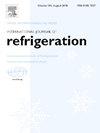CFD simulation analysis and visualization experimental study of gas contamination condensation distribution in coaxial pulse tube cryocooler
IF 3.5
2区 工程技术
Q1 ENGINEERING, MECHANICAL
International Journal of Refrigeration-revue Internationale Du Froid
Pub Date : 2025-03-10
DOI:10.1016/j.ijrefrig.2025.03.016
引用次数: 0
Abstract
Condensable gas contamination is one of important factors limiting the longevity of pulse tube coolers. To further understand the way in which contamination affect the performance of pulse tube cooler, the behavioral characteristics of the contamination inside the pulse tube cooler were investigated. In this study, a 2-D simulation model of the regenerator was developed, and the diffusion and phase change distribution characteristics of the contamination at the cold end were investigated by CFD method. The transition of gas flow and pressure loss caused by the contamination were analyzed. The results show that condensation occurs first in the pulse tube and distribute mainly in the pulse tube and the regenerator eventually. The transition of the gas flow state due to the accumulation of contamination is likely to be an important cause of degradation in the performance of pulse tube cooler. And contamination will accumulate in the flow straightener when the cooling temperature closer to the saturation temperature, which can further affect the state of gas flow in the pulse tube, resulting in higher pressure losses. In addition, based on the technology of neutron radiography, a visualization experiment on the accumulation of contamination in pulse tube cooler was completed, and the experimental results were compared with the simulation results.
同轴脉冲管制冷机内气体污染冷凝分布的CFD模拟分析及可视化实验研究
可冷凝气体污染是限制脉冲管冷却器寿命的重要因素之一。为了进一步了解污染对脉管冷却器性能的影响,对脉管冷却器内部污染的行为特征进行了研究。本文建立了蓄热器的二维仿真模型,利用CFD方法研究了污染物在冷端扩散和相变分布特征。分析了污染引起的气体流动转变和压力损失。结果表明:冷凝首先发生在脉冲管内,最终主要分布在脉冲管内和蓄热器内;由于污染物的积累而引起的气体流动状态的转变很可能是导致脉冲管冷却器性能下降的重要原因。当冷却温度接近饱和温度时,污染会在流动矫直器中积累,进一步影响脉冲管内气体流动状态,造成更高的压力损失。此外,基于中子射线照相技术,完成了脉管冷却器内污染物积累的可视化实验,并将实验结果与仿真结果进行了对比。
本文章由计算机程序翻译,如有差异,请以英文原文为准。
求助全文
约1分钟内获得全文
求助全文
来源期刊
CiteScore
7.30
自引率
12.80%
发文量
363
审稿时长
3.7 months
期刊介绍:
The International Journal of Refrigeration is published for the International Institute of Refrigeration (IIR) by Elsevier. It is essential reading for all those wishing to keep abreast of research and industrial news in refrigeration, air conditioning and associated fields. This is particularly important in these times of rapid introduction of alternative refrigerants and the emergence of new technology. The journal has published special issues on alternative refrigerants and novel topics in the field of boiling, condensation, heat pumps, food refrigeration, carbon dioxide, ammonia, hydrocarbons, magnetic refrigeration at room temperature, sorptive cooling, phase change materials and slurries, ejector technology, compressors, and solar cooling.
As well as original research papers the International Journal of Refrigeration also includes review articles, papers presented at IIR conferences, short reports and letters describing preliminary results and experimental details, and letters to the Editor on recent areas of discussion and controversy. Other features include forthcoming events, conference reports and book reviews.
Papers are published in either English or French with the IIR news section in both languages.

 求助内容:
求助内容: 应助结果提醒方式:
应助结果提醒方式:


